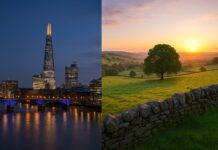Winding lanes, golden cottages, and riverside bridges — England’s villages seem painted from a storybook. These are places where time drifts slowly, flowers spill from stone walls, and every street corner tells a tale of centuries past. Whether you crave calm, photography, or heritage, these ten English villages embody the magic of rural Britain.
Introduction: The Timeless Allure of English Villages
England’s countryside holds a beauty that is both humble and enchanting. Beyond the bustle of London or the landmarks of Oxford lie landscapes shaped by tradition, community, and nature. Here, life moves at the pace of footsteps, not deadlines.
Each English village is a world in miniature — with its church spire, village green, local inn, and a tapestry of stories stitched across centuries. These places survived wars, industry, and modernity while keeping their old-world grace intact.
When you visit, you’ll discover:
- Architecture built from local stone — honey-hued in the Cotswolds, grey and rugged in the Dales.
- Rivers, bridges, and mills that once powered village life.
- Charming pubs and tea rooms offering comfort beside fireplaces that have warmed travellers for generations.
- Friendly locals who value heritage and community as much as beauty itself.
Below, we explore ten English villages that seem lifted straight from the pages of a classic novel — places where you can see, feel, and even smell the poetry of the countryside.
1. Bibury, Gloucestershire — The Crown Jewel of the Cotswolds
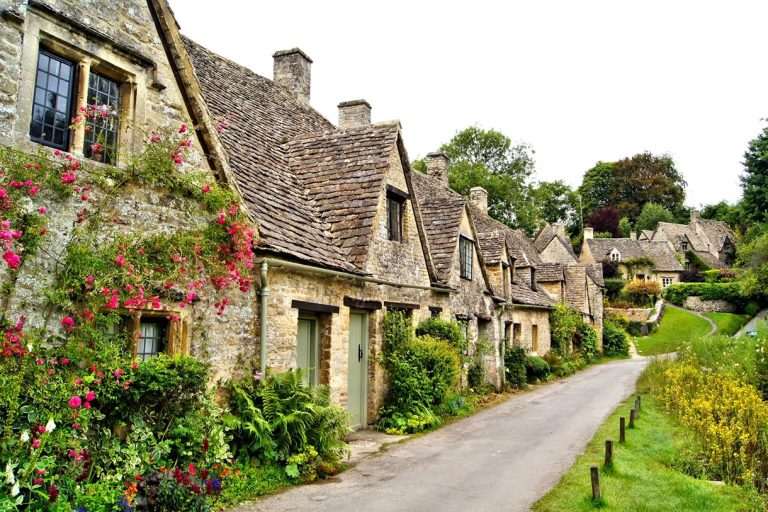
Bibury is often called the most beautiful village in England, and it’s easy to see why. The River Coln runs softly past golden cottages, while willows lean lazily over the water. Arlington Row, with its storybook weavers’ cottages, has become an emblem of rural Britain.
Historical Background
- Bibury dates back to the Saxon period and appears in the Domesday Book (1086) as Becheberie.
- The 14th-century Arlington Row was originally a wool store for monks.
- By the 17th century, it had been converted into cottages for local weavers.
- Bibury thrived through the wool trade, supplying cloth to markets across England.
What Makes Bibury Special
- Architecture: The cottages’ golden limestone is unique to the Cotswolds, glowing warm in sunlight.
- Natural beauty: The River Coln creates a mirror-like reflection of Arlington Row — a photographer’s dream.
- Cultural recognition: Featured on the inside cover of British passports.
Things to Do
- Walk along Arlington Row and watch the light shift over the cottages.
- Visit St Mary’s Church, built in the 12th century, with its intricate Norman carvings.
- Enjoy a meal or cream tea by the river.
- Visit Bibury Trout Farm, one of Britain’s oldest, established in 1902.
Travel Tip
Bibury can get crowded during summer. Visit early in the morning or during spring and autumn for quiet walks and perfect light.
2. Castle Combe, Wiltshire — A Village Frozen in Time
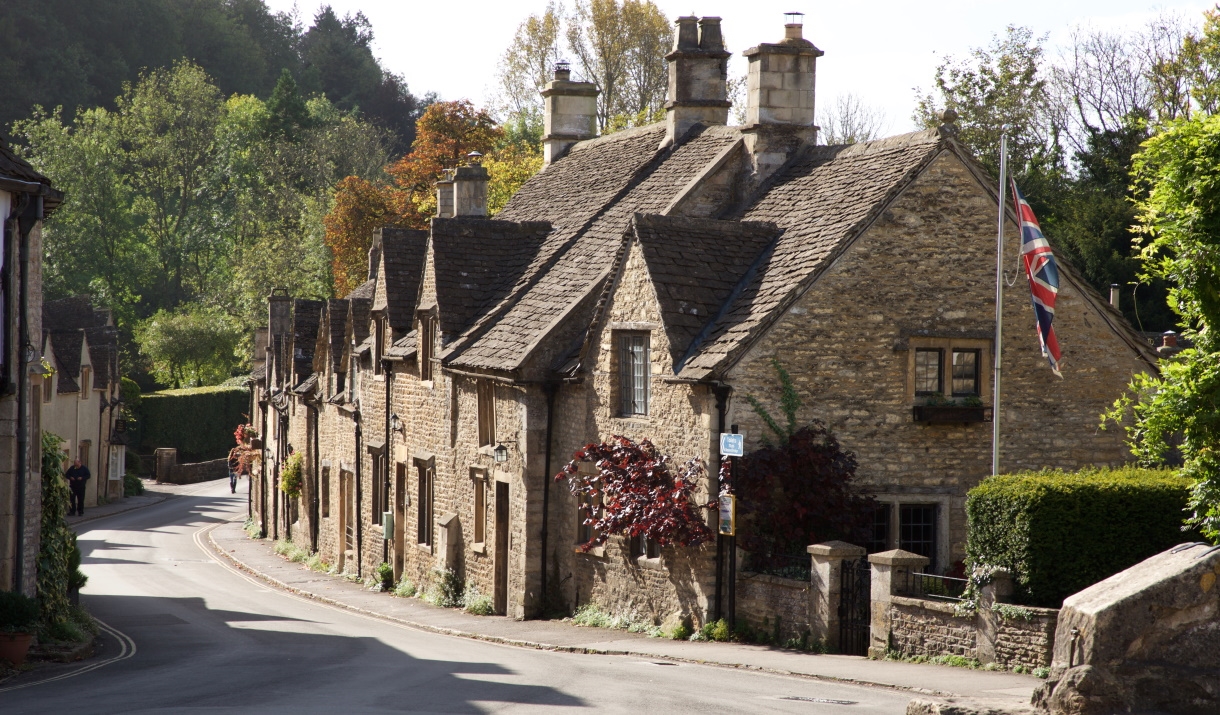
Castle Combe feels like walking into a dream. No modern streetlights, no power lines — just pure, preserved charm. It has been voted England’s prettiest village countless times, and with good reason.
Historical Background
- Named after a 12th-century Norman castle, now in ruins.
- Flourished during the medieval wool industry, producing high-quality cloth.
- Declined after the 15th century, leaving it untouched by industrialisation.
- Served as a filming location for War Horse, Stardust, and Downton Abbey.
Why You’ll Love Castle Combe
- Authentic medieval layout — narrow lanes, stone cottages, and an ancient Market Cross.
- Bybrook River runs through the heart of the village, crossed by a stone bridge.
- St Andrew’s Church houses one of England’s oldest working clocks (13th century).
Things to Do
- Walk down the main street and take in the honey-stone architecture.
- Visit the old churchyard for peaceful views.
- Have lunch at The Castle Inn, a 12th-century coaching inn.
- Explore nearby Castle Combe Circuit if you enjoy motorsport.
Travel Tip
Parking is limited; use the public car park above the village and stroll down. The best photos are taken from the bridge looking back up the high street.
3. Hawkshead, Cumbria — Heart of the Lake District
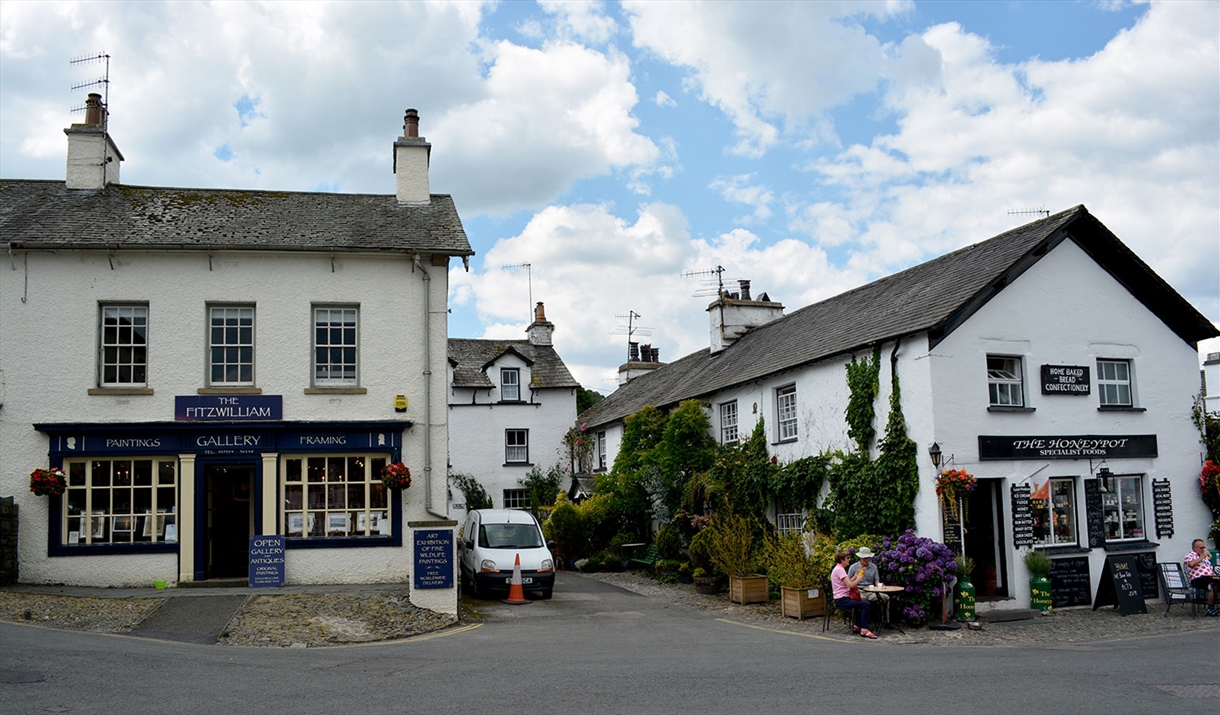
In the midst of the Lake District lies Hawkshead, a whitewashed wonder surrounded by lush fells and mirrorlike lakes. Its charm lies in its simplicity — cobbled squares, tiny shops, and literary heritage that shaped English imagination.
Historical Background
- Founded by Norse settlers around the 10th century.
- Became a wool and market town under the monks of Furness Abbey.
- William Wordsworth studied here in the 1770s.
- Beatrix Potter owned property nearby, now managed by the National Trust.
Why Visit Hawkshead
- Architecture: Stone and slate cottages with wooden balconies typical of Cumbria.
- Literary connection: Wordsworth’s desk is still visible in the old Grammar School Museum.
- Natural setting: Close to Esthwaite Water and Grizedale Forest — perfect for hikes.
Things to Do
- Visit the Beatrix Potter Gallery to see her original artwork.
- Explore Hawkshead Church for views over the rooftops.
- Enjoy a pub lunch with local ale at The Sun Inn or The Red Lion.
Travel Tip
Cars are restricted inside the village — park outside and walk in to preserve its quiet charm.
4. Lower Slaughter, Gloucestershire — England’s Peaceful Treasure

Lower Slaughter is the kind of place where time moves with the river. The name may sound ominous, but it comes from slough, meaning “wetland.” With its crystal-clear stream and iconic watermill, this Cotswold village is pure serenity.
Historical Background
- Settled since Saxon times; recorded in the Domesday Book.
- The village grew around the River Eye and its 19th-century watermill.
- The Old Mill Museum now showcases the village’s agricultural heritage.
Why It’s So Captivating
- Tranquil scenery: Ducks gliding past old stone bridges.
- Architecture: Honey-coloured cottages with ivy-covered walls.
- Quiet atmosphere: No shops or commercial clutter — just pure countryside stillness.
Things to Do
- Walk the river path between Lower and Upper Slaughter.
- Visit the Old Mill Museum and café for local history and treats.
- Enjoy a slow cycle ride through the surrounding meadows.
Travel Tip
Come at dawn or dusk — the soft light and calm air make it one of the most photogenic villages in England.
5. Broadway, Worcestershire — Th Jewel of the Cotswolds
Broadway is the Cotswolds at its most elegant — a blend of beauty, history, and cultural richness. Its wide main street, lined with tea rooms, art galleries, and boutiques, gives it a lively yet relaxed feel.
Historical Background
- Lies on the ancient Roman Fosse Way.
- Flourished as a coaching stop between Worcester and London in the 17th century.
- Became a centre for the Arts and Crafts movement in the late 1800s.
- Broadway Tower, built in 1798, served as a creative retreat for artists like William Morris.
Highlights
- Architecture: Honey-stone buildings with Georgian façades.
- Cultural heritage: Home to artisans, writers, and galleries.
- Scenic views: Surrounded by the rolling Cotswold escarpment.
Things to Do
- Climb Broadway Tower for panoramic countryside views.
- Visit local art galleries such as John Noott or Priory Gallery.
- Shop for antiques or handmade crafts.
- Dine at The Lygon Arms, a 14th-century hotel that hosted kings and creatives alike.
Travel Tip
Broadway is especially stunning in autumn when the trees lining the high street turn amber and gold.
6. Shere, Surrey — The Fairytale Village Near London

Just an hour from London, Shere offers a perfect countryside escape. With its thatched cottages, winding lanes, and tranquil pond, it looks lifted from a Christmas card.
Historical Background
- First mentioned in records from 1086.
- The Church of St James, dating to the 12th century, remains the village centrepiece.
- Became famous after featuring in films like The Holiday (2006).
Why You’ll Adore Shere
- Idyllic setting: Nestled in the Surrey Hills Area of Outstanding Natural Beauty.
- Picturesque lanes: Lined with boutique shops, cafés, and tearooms.
- Heritage vibe: Retains its traditional village layout and charm.
Things to Do
- Visit St James Church and the village pond.
- Explore the Surrey Hills trails nearby for scenic walks.
- Enjoy a meal at The White Horse, a historic pub featured in The Holiday.
Travel Tip
It’s ideal for a day trip from London — especially in spring when blossoms reflect on the pond’s surface.
7. Lacock, Wiltshire — Where History Lives On

Lacock is not just picturesque — it’s a living museum. Owned by the National Trust, it’s one of England’s best-preserved medieval villages, famous for its role in television and film.
Historical Background
- Founded in the 13th century by Ela, Countess of Salisbury.
- Home to Lacock Abbey, built in 1229.
- In the 19th century, resident William Henry Fox Talbot invented the first photographic negative here.
- The village’s appearance is largely unchanged for over 700 years.
What to Expect
- Cobbled streets and timbered houses.
- Historic shopfronts that transport you to the Georgian era.
- Filming heritage: Seen in Harry Potter, Downton Abbey, and Pride and Prejudice.
Things to Do
- Tour Lacock Abbey and the Fox Talbot Museum.
- Visit The Sign of the Angel, a 15th-century inn for lunch.
- Wander the lanes at twilight for atmospheric photos.
Travel Tip
Stay overnight in Lacock if possible — it’s magical after sunset when the crowds vanish and lanterns glow on the cobbles.
8. Kettlewell, North Yorkshire — The Soul of the Dales
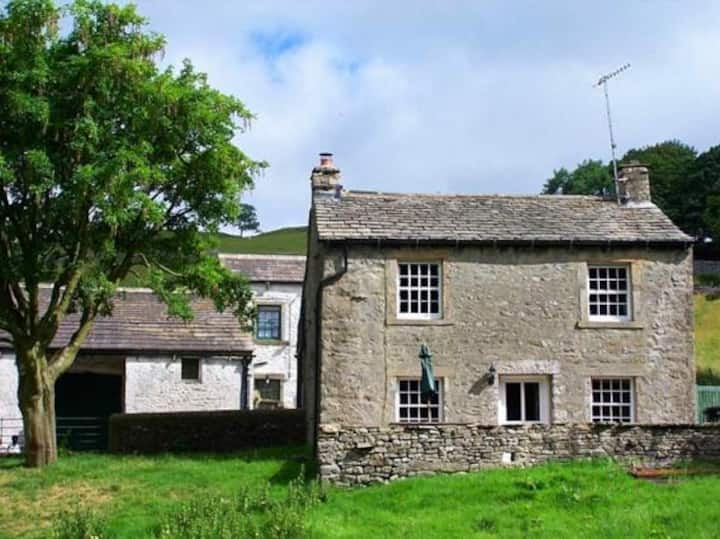
Kettlewell, tucked in the Yorkshire Dales, offers rugged northern beauty. Grey-stone cottages sit beside a sparkling beck, surrounded by green hills that stretch into the distance.
Historical Background
- Once part of the Fountains Abbey estates in the 13th century.
- Prosperity came from lead mining and sheep farming.
- The village maintained its simple agricultural lifestyle into the modern era.
Why Visit
- Authentic Dales life: Friendly locals, hearty food, and genuine charm.
- Scenery: Rolling moorlands and limestone hills perfect for walkers.
- Community spirit: Known for its annual Scarecrow Festival, attracting visitors from across the country.
Things to Do
- Walk along the River Wharfe or hike nearby Buckden Pike.
- Enjoy traditional Yorkshire dishes at The Blue Bell Inn.
- Explore Kettlewell Church, built in 1820 with panoramic views.
Travel Tip
For photographers, Kettlewell is best visited in early autumn — mist, golden leaves, and stone create a natural masterpiece.
9. Rye, East Sussex — Cobblestone Stories by the Sea
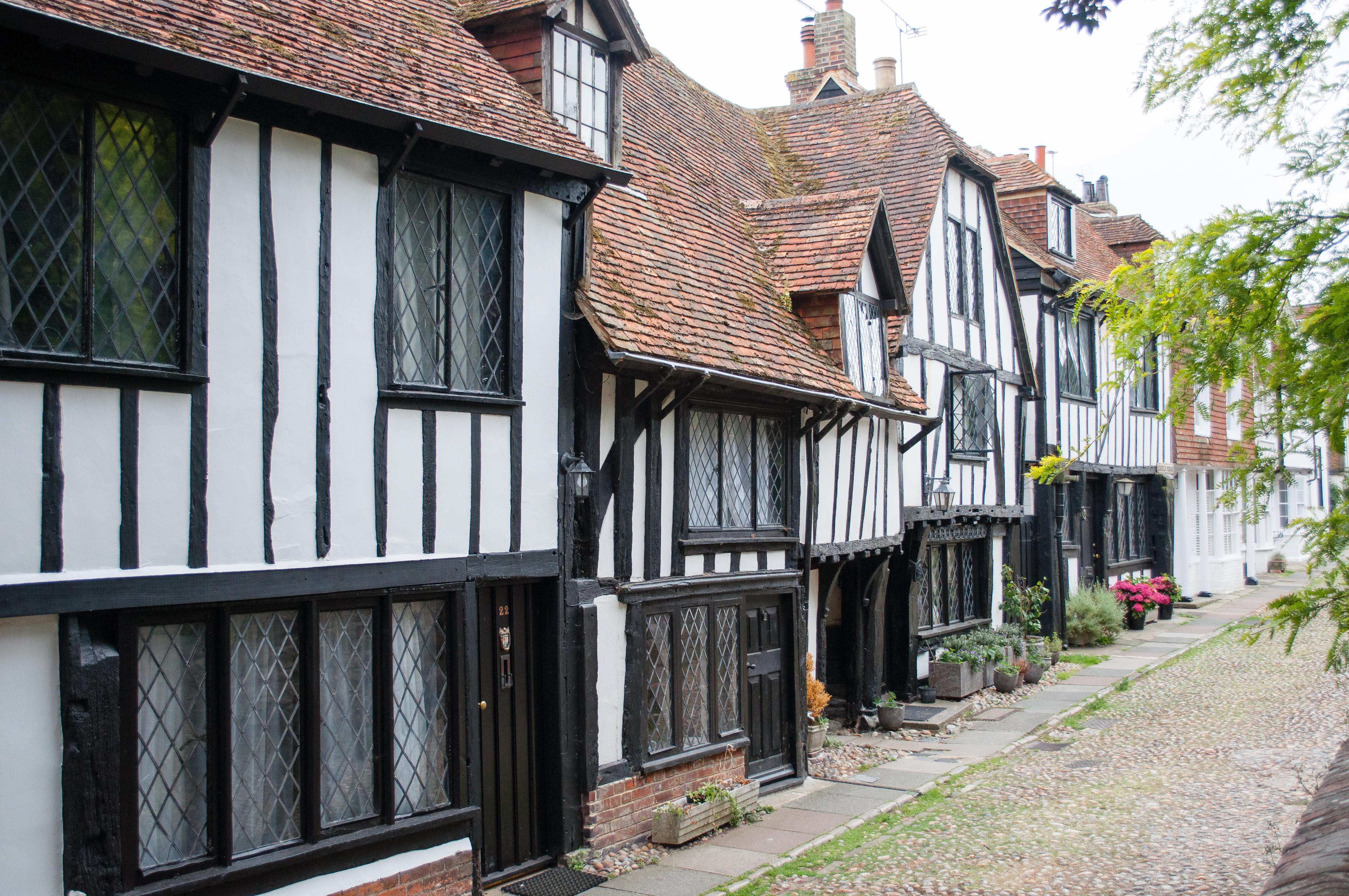
Rye is one of England’s most atmospheric villages — medieval, coastal, and hauntingly beautiful. Cobbled streets twist through crooked timber houses, while the salty wind carries echoes of its smuggling past.
Historical Background
- Once a Cinque Port on the coast, vital for medieval trade and defence.
- Suffered repeated French raids in the 14th century, leading to fortified walls.
- Prosperity followed through shipbuilding and fishing.
- Its harbour silted up over time, preserving Rye as a hilltop relic.
Why It’s Unforgettable
- Mermaid Street: Possibly the most photographed lane in England.
- The Mermaid Inn: Rebuilt in 1420; once home to notorious smugglers.
- Literary legacy: Writers like Henry James and E.F. Benson found inspiration here.
Things to Do
- Climb St Mary’s Church tower for sweeping marsh views.
- Visit Lamb House, Henry James’s Georgian home.
- Explore Rye Harbour Nature Reserve for coastal wildlife.
Travel Tip
Rye is best experienced in the late afternoon when golden light hits the cobbles and history feels almost tangible.
10. Stanton, Gloucestershire — A Hidden Cotswold Secret

If you prefer peace over popularity, Stanton is your paradise. Small, secluded, and virtually unchanged for centuries, it’s the Cotswolds in its purest form.
Historical Background
- Mentioned in the Domesday Book (1086).
- Flourished through wool and farming under monastic estates.
- 16th- and 17th-century cottages remain nearly untouched.
- Carefully restored by architect Sir Gordon Russell in the 20th century.
Why Stanton Stands Out
- Unspoiled landscape: Overlooks the Vale of Evesham with panoramic views.
- Architectural integrity: Every house built from local Cotswold limestone.
- Quiet charm: No shops, just cottages, gardens, and a centuries-old pub.
Things to Do
- Visit St Michael’s Church, dating from the 12th century.
- Walk up Shenberrow Hill for breathtaking views.
- Enjoy a pint at The Mount Inn, where the terrace overlooks golden fields.
Travel Tip
Arrive during golden hour — Stanton’s cottages glow with an otherworldly warmth as the sun dips.
Comparative Table of the Ten Villages
| Village | County | Signature Feature | Visit Ideal Time |
|---|---|---|---|
| Bibury | Gloucestershire | Honey-stone weavers’ cottages & river setting | Spring/early summer |
| Castle Combe | Wiltshire | “Prettiest village”, stone bridge & Bybrook stream | Late summer/early autumn |
| Hawkshead | Cumbria | Lake District charm + literary heritage | June (pleasant weather) |
| Lower Slaughter | Gloucestershire | Tranquil stream-side village | Early morning, low crowds |
| Broadway | Worcestershire | Elevated views + high street blend | Late afternoon |
| Shere | Surrey | Thatched roofs, pond and Surrey Hills backdrop | Mid-spring |
| Lacock | Wiltshire | Historic architecture + film locations | Off-peak season |
| Kettlewell | Yorkshire Dales | Rugged hills + riverside village | Autumn (foliage) |
| Rye | East Sussex | Medieval lanes + proximity to marsh/coast | Anytime but summer tips |
| Stanton | Gloucestershire | Quiet, unspoiled village | Weekday in shoulder season |
Practical Travel Tips for Exploring English Villages
- Best time to visit: April to October for mild weather and long days.
- Transport: Public buses are limited — hiring a car allows flexibility.
- Stay local: Choose heritage inns or family-run B&Bs for an authentic experience.
- Be respectful: Many villages are residential; keep noise low and stick to paths.
- Carry cash: Smaller cafés and tearooms may not accept cards.
- Don’t rush: The beauty lies in wandering slowly — every corner hides a story.
FAQs
1. Which English village is considered the most beautiful?
Castle Combe in Wiltshire is often crowned as the prettiest village in England because of its perfectly preserved medieval charm. Its honey-stone cottages, arched bridge over the Bybrook River, and cobbled high street appear untouched for centuries. The absence of streetlights, signage, and modern distractions gives it an almost cinematic stillness. Whether you’re walking at sunrise or twilight, Castle Combe feels like stepping through the pages of a timeless English romance.
2. What is the best time to explore these villages?
The best time to explore England’s storybook villages is between April and October, when mild temperatures, longer daylight hours, and blooming gardens create the ideal atmosphere for walks and photography. Spring offers wildflowers and lambs in the fields, summer brings lively markets and tea gardens, and autumn cloaks the countryside in golden hues. Winter can be quiet and charming too, with frost-tipped cottages and roaring pub fires adding to that magical, postcard-perfect feeling.
3. Can I visit multiple villages in one trip?
Yes. Many of England’s most beautiful villages lie close together, especially in the Cotswolds region, where Bibury, Broadway, Lower Slaughter, and Stanton can easily be explored over two or three days. A self-drive route allows you to move at your own pace and stop for photos, meals, or short walks. Alternatively, guided coach tours offer day trips combining several Cotswold gems with nearby historic towns like Bath or Oxford, ensuring a balanced and relaxed experience.
4. Are these villages accessible by public transport?
Some of the larger or better-known villages—such as Rye, Broadway, or Lacock—are reachable by regional trains or local buses, but smaller settlements like Lower Slaughter and Stanton require a car or taxi for easy access. Renting a vehicle offers the freedom to stop at hidden viewpoints and explore lesser-known hamlets nearby. If you prefer not to drive, many companies offer small-group countryside tours departing from London, Bath, or Oxford, designed for comfortable and stress-free travel.
5. What local foods should I try while visiting?
Each region has its own culinary personality. In the Cotswolds, try creamy Double Gloucester cheese, homemade scones with clotted cream, and farm-fresh produce at local markets. Up north, Yorkshire’s villages serve hearty steak-and-ale pies and Wensleydale cheese. Near the coast, Rye’s seafood—especially scallops—is a must. Many traditional pubs and inns serve seasonal dishes sourced within a few miles. Don’t miss a Sunday roast beside a crackling fire, followed by sticky toffee pudding for a truly British treat.
6. Are there good accommodation options in these villages?
Absolutely. Most English villages offer a charming range of accommodations—from centuries-old coaching inns with oak beams and fireplaces to cosy B&Bs run by local families. In places like Broadway or Bibury, you can even stay in restored cottages overlooking flower-filled gardens. For a touch of luxury, boutique hotels in the Cotswolds blend modern comfort with heritage design. Booking early is wise, especially in summer, as many properties are small and fill quickly due to their limited size and popularity.
7. Why do English villages attract photographers and artists?
English villages enchant photographers and artists because they blend natural beauty with preserved architecture in a way few places do. The play of light on honey-stone walls, reflections in gentle rivers, and floral cottages framed by church spires create compositions that look effortlessly timeless. Many artists of the Arts and Crafts movement drew inspiration here, especially in Broadway and Bibury. Every season transforms the scenery—from spring blossoms to snowy rooftops—making these villages an endless canvas for creativity and emotion.
Conclusion: Living Pages of England’s Past
England’s villages are more than destinations — they are living, breathing pieces of history. Each lane and church tower whispers of farmers, poets, craftsmen, and dreamers who built lives here centuries ago.
From Bibury’s golden cottages to Rye’s cobbled secrets, these villages remind us that beauty is timeless when preserved with care. They offer the serenity of nature, the comfort of heritage, and the quiet joy of belonging to a story that began long before us — and will continue long after.
So pack your walking shoes, bring your curiosity, and let England’s storybook villages remind you of the simple magic of slowing down.

